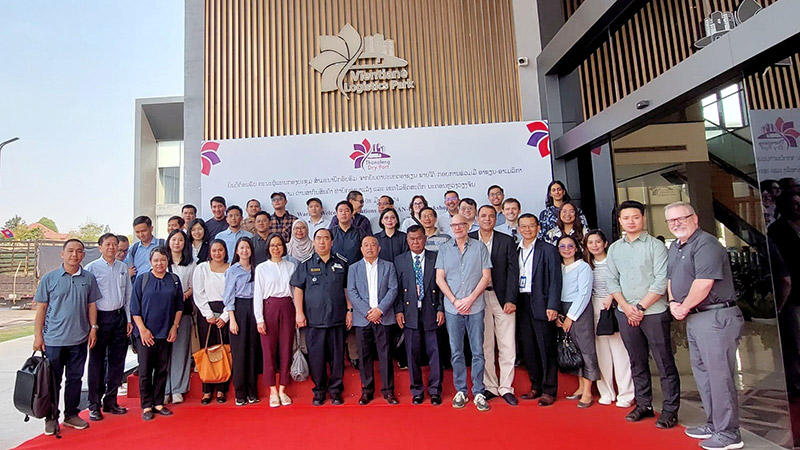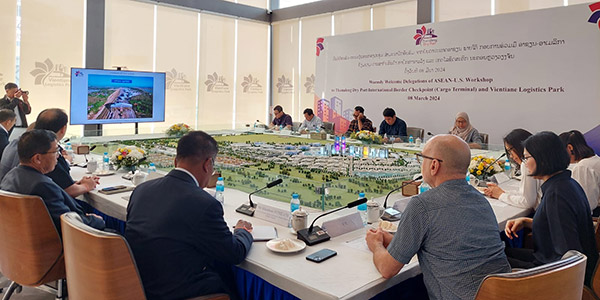

Integrating with logistics centres across the region and beyond, the Thanaleng Dry Port in Vientiane offers numerous opportunities for business operators, its developer has said.
The dry port functions as an International Border Checkpoint (Cargo Terminal) where the Laos-China and Laos-Thailand railways converge. It has become an important trade gateway between emerging markets in Southeast Asia and China, the world’s second largest economy.
“We are a dry port in a landlocked country serving as an overland port within ASEAN,” the facility’s Managing Director Mr Sakhone Philangam told visitors on Friday.

“We categorise ourselves as a port of ASEAN. Next door to us is China.”
Delegates attending an ASEAN-US workshop visited the dry port and its associated Vientiane Logistics Park to learn about its operations and the opportunities offered by Laos’ integrated logistics centre.
The dry port and logistics park were designed to bolster the Lao government’s efforts to transform Laos into a land-link country.
From the dry port, freight is shipped overland to Thailand and can reach Malaysia. The Lao dry port’s operator has signed a Memorandum of Cooperation with the Malaysian operator of the Perlis Inland Port, seeking to reach the Andaman Sea. From there, cargo could be forwarded to Indonesia.
In the other direction, the Laos-China Railway links to the China-Europe rail network running through Kazakhstan, Russia, Belarus, Poland and Germany.
The director said the dry port, which opened for service in December 2021, has handled an increasing volume of freight, notably from neighbouring Thailand from where large amounts of farm produce, mostly durian, are shipped by rail to China. This direct route has enabled Thai exporters to cut transport time as well as costs by about 30 percent compared to road transport from Thailand to China.
In 2022, the dry port handled 49,183 containers, of which 36,768 were destined for import and export, while 12,415 containers were in transit. The containers were shipped to countries such as Thailand, Vietnam, Cambodia, Myanmar, Malaysia, Singapore, China and Russia.
To further speed up trade and freight transport, notably farm produce, the Lao investor is working with China to build a Sanitary and Phytosanitary (SPS) service centre in the park. Products certified at the centre could then quickly enter China.
“This quarantine centre aims to facilitate trade. We are the next immediate neighbour of ASEAN and China,” the director said.
To leverage this improved connectivity, Vientiane Logistics Park Co., Ltd. – the developer of the dry port and Vientiane Logistics Park – is also building a US$547-million logistics park to attract additional foreign investment. The park includes an export processing zone, a logistics centre, a free trade zone, and a technology and halal hub.
Mr Sakhone said his team is negotiating with a Malaysian company to establish a halal hub in the zone to benefit from the potential brought about by the Laos-China railway and China-Europe railway running through central Asia – a big market for halal food. Indonesia is also a big market for halal food.
Setting up a cold chain service is another area of opportunity, the director said, given the low cost of electricity in Laos, which is just half the cost of that in neighbouring Thailand, he added.
Given that electricty in Laos is sourced from hydropower – a clean form of engergy – investment in Laos contributes to a green growth economy, which the international community is pushing for, he said.
In addition, investors in Laos benefit from a number of incentives, including a corporate tax holiday of eight to 16 years and reduced Value-Added Tax.
Goods manufactured or assembled in Laos also enjoy privileged access to markets in countries whose governments have waived or reduced import tariffs on made-in-Laos products. More than 30 countries, including Australia, Canada, members of the European Union (EU 28), Japan, New Zealand, Norway, Russia, Switzerland and Turkiye have extended such privileges to Laos.
Mr Sakhone informed the guests that the dry port and Vientiane Logistics Park are crucial components of the Lao Logistics Link project, being developed by PTL Holding Company Limited – the parent company of Vientiane Logistics Park Co., – in partnership with the Lao and Vietnamese governments. The project includes the Vung Ang seaport in Vietnam’s central Ha Tinh province, a planned railway linking the seaport to Thanaleng Dry Port, and a dry port and a planned coal-fired power plant in central Khammuan province through which the railway will pass. Through this route, freight could reach markets in the Pacific region.
With the improved logistics links, trade and investment potential, and the many incentives on offer, Mr Sakhone said “This is a new opportunity for ASEAN.”